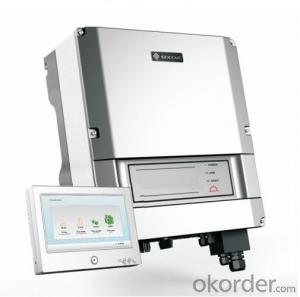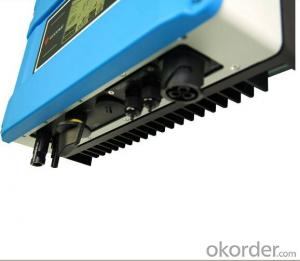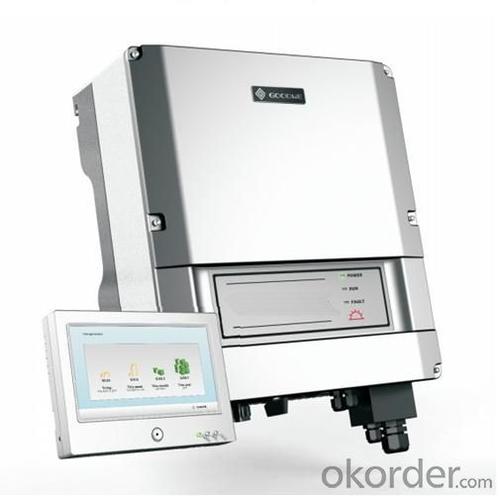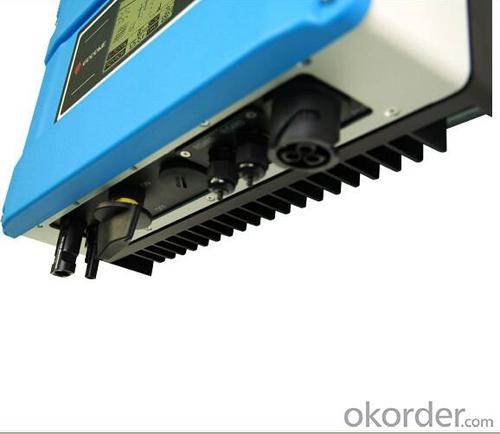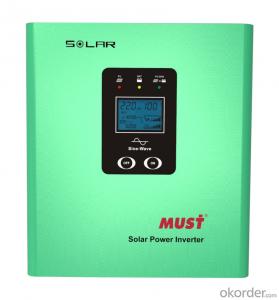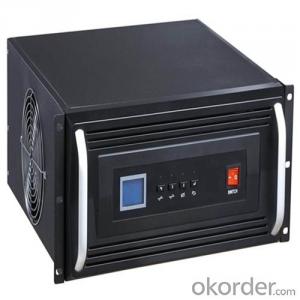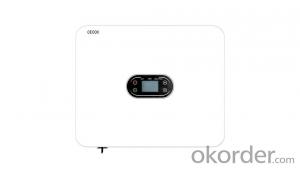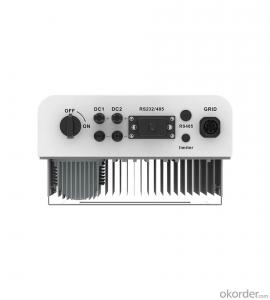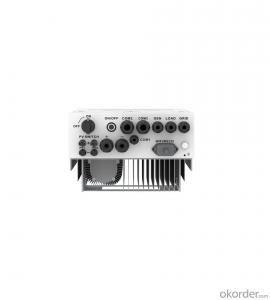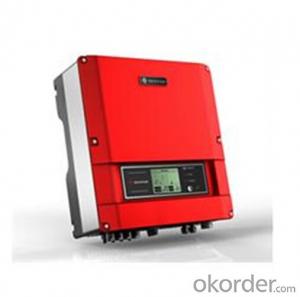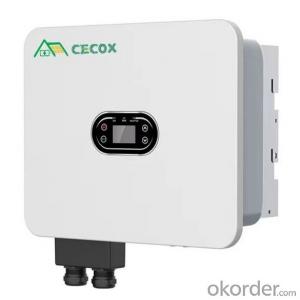6KW Solar Inverter GW4600D-JP Single Phase
- Loading Port:
- Shanghai
- Payment Terms:
- TT OR LC
- Min Order Qty:
- 12 pc
- Supply Capability:
- 1000 pc/month
OKorder Service Pledge
OKorder Financial Service
You Might Also Like
GW4600D-JP
1. specification
JP Series Inverter is suitable to the domestic applications, and designed under modern ID concept, it has created a new standard for inverter technology with more advanced reactive compensation technology and dual MPPT trackers. Not only be able to connect with two phase grid system, this model but also could run as off-grid model, and the wide range of frequency of 50/60Hz makes it a good choice for Japan market. Moreover, the specialized monitor could perfectly control the inverter operation and data logging. IP65 high protective class of housing ensures the inverter work persistently and steadily under all critical environment.
2.Datasheet
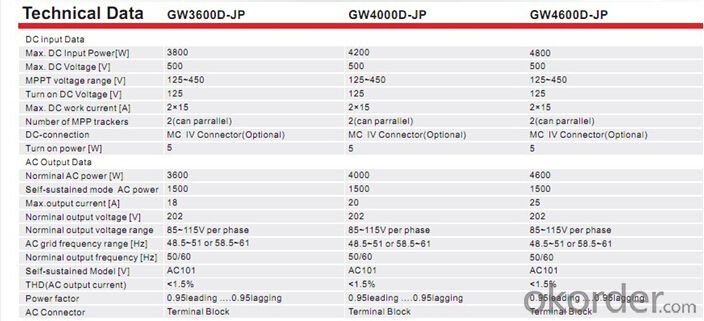
3. product certificate
EN 61000
VDE 0126-1-1
C10/11
G83/2
UTE C15-712-1
AS4777
CQC
CE10-21
EN50438
4.product picture
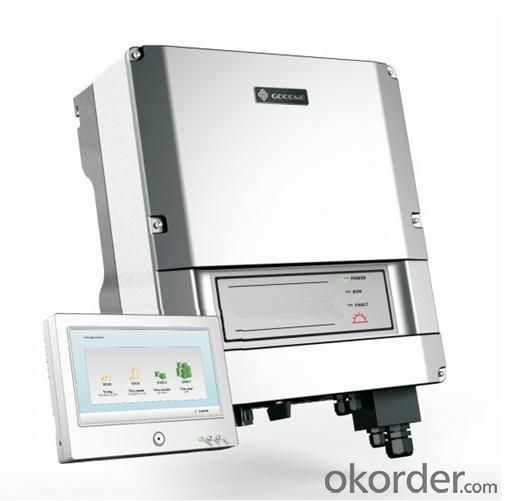
FAQ
1. How long will my inquiry get response?
Your inquiry related to our products or prices will be replied within 24 hours.
2. Can I get professional service and suggestion?
Well-trained and experienced staffs to answer all your questions in fluent English.
3. Do you accept OEM or customized design?
OEM & ODM, any your customized lightings we can help you to design and put into product.
4. What if I need specific design?
Distributorship are offered for your unique design and some our current models.
- Q: Can a solar inverter be used with solar-powered streetlights?
- Yes, a solar inverter can be used with solar-powered streetlights. A solar inverter is responsible for converting the direct current (DC) produced by solar panels into alternating current (AC) that can be used to power various electrical devices, including streetlights. By integrating a solar inverter into the system, solar-powered streetlights can efficiently utilize the energy captured from the sun to illuminate the streets.
- Q: Can a solar inverter be used with different types of solar cell technologies?
- Yes, a solar inverter can be used with different types of solar cell technologies. Solar inverters are designed to convert the DC electricity generated by solar panels, regardless of the type of solar cell technology, into AC electricity that can be used to power homes and businesses. Therefore, whether it is monocrystalline, polycrystalline, thin-film, or any other solar cell technology, a solar inverter can efficiently convert the generated electricity into usable form.
- Q: What are the advantages of using a three-phase solar inverter?
- There are several advantages to using a three-phase solar inverter. Firstly, three-phase solar inverters allow for higher power output compared to single-phase inverters. This is because they distribute the power across three phases, resulting in increased efficiency and capacity. Additionally, three-phase inverters provide better voltage stability and balance across the three phases of a power grid. This is particularly beneficial in commercial or industrial settings where there may be heavy loads and varying power demands. Furthermore, three-phase solar inverters offer improved reliability and durability. They are designed to handle higher currents and can withstand higher temperatures, ensuring a longer lifespan and reducing maintenance requirements. Lastly, three-phase inverters are more cost-effective in large-scale solar installations. They allow for better utilization of available grid infrastructure, reducing transmission losses and optimizing power distribution. Overall, the advantages of using a three-phase solar inverter include higher power output, improved voltage stability, enhanced reliability, and cost-effectiveness in larger-scale installations.
- Q: Can a solar inverter be used with different grid voltages?
- No, a solar inverter cannot be used with different grid voltages. Solar inverters are designed to convert the DC power generated by solar panels into AC power that matches the specific voltage and frequency of the grid. Using a solar inverter with different grid voltages can cause damage to the inverter and can also be a safety hazard.
- Q: What is the role of transformerless design in a solar inverter?
- The role of transformerless design in a solar inverter is to eliminate the use of a bulky and costly transformer, which helps reduce the overall size, weight, and cost of the inverter. Additionally, a transformerless design allows for higher efficiency and improved performance of the solar inverter.
- Q: How does a solar inverter handle low light conditions or cloudy days?
- A solar inverter handles low light conditions or cloudy days by continuously monitoring the incoming solar energy. When there is a decrease in sunlight, the inverter adjusts its voltage and current output to optimize the power conversion. This ensures that even under low light conditions, the inverter can still convert the available solar energy into usable electricity efficiently.
- Q: Can a solar inverter be used with a monitoring system?
- Yes, a solar inverter can be used with a monitoring system. In fact, many solar inverters are equipped with built-in monitoring capabilities, allowing users to track the performance and output of their solar energy system in real-time. Additionally, there are also external monitoring systems available that can be integrated with a solar inverter to provide more advanced monitoring features and data analysis.
- Q: Can a solar inverter be used off-grid?
- Yes, a solar inverter can be used off-grid. Off-grid solar systems typically include batteries to store excess energy generated by the solar panels. The solar inverter converts the direct current (DC) power from the solar panels into alternating current (AC) power, which can be used to power household appliances and devices. This allows for the use of solar energy even when there is no access to the main electricity grid.
- Q: Can a solar inverter be used with building-integrated photovoltaics (BIPV)?
- Yes, a solar inverter can be used with building-integrated photovoltaics (BIPV). The solar inverter is an essential component that converts the DC power generated by the BIPV system into AC power suitable for use in buildings. It ensures efficient utilization of the solar energy produced by the BIPV system and enables integration with the electrical grid or building's power system.
- Q: How does a solar inverter handle voltage fluctuations?
- A solar inverter handles voltage fluctuations by continuously monitoring the input voltage from the solar panels. When there is a fluctuation in the input voltage, the inverter adjusts its internal circuitry to ensure a stable and consistent output voltage. This helps protect the connected appliances and grid from potential damage caused by sudden voltage changes.
Send your message to us
6KW Solar Inverter GW4600D-JP Single Phase
- Loading Port:
- Shanghai
- Payment Terms:
- TT OR LC
- Min Order Qty:
- 12 pc
- Supply Capability:
- 1000 pc/month
OKorder Service Pledge
OKorder Financial Service
Similar products
Hot products
Hot Searches
Related keywords
